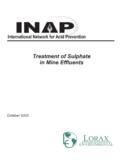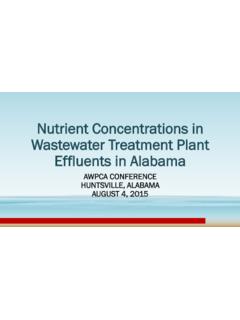Transcription of Opportunities and challenges
1 BIOFUEL CO-PRODUCTS AS LIVESTOCK FEED Opportunities and challengesFOOD AND AGRICULTURE ORGANIZATION OF THE UNITED NATIONSRome, 2012 BIOFUEL CO-PRODUCTS AS LIVESTOCK FEED Opportunities and challengesEditor Harinder MakkarRecommended citationFAO. 2012. Biofuel co-products as livestock feed - Opportunities and challenges , edited by Harinder Makkar. designations employed and the presentation of material in this information product do not imply the expression of any opinion whatsoever on the part of the Food and Agriculture Organization of the United Nations (FAO) concerning the legal or development status of any country, territory, city or area or of its authorities, or concerning the delimitation of its frontiers or boundaries. The mention of specific companies or products of manufacturers, whether or not these have been patented, does not imply that these have been endorsed or recommended by FAO in preference to others of a similar nature that are not views expressed in this information product are those of the author(s) and do not necessarily reflect the views of 978-92-5-107299-8 All rights reserved.
2 FAO encourages reproduction and dissemination of material in this information product. Non-commercial uses will be authorized free of charge, upon request. Reproduction for resale or other commercial purposes, including educational purposes, may incur fees. Applications for permission to reproduce or disseminate FAO copyright materials, and all queries concerning rights and licences, should be addressed by e-mail to or to the Chief, Publishing Policy and Support Branch, Office of Knowledge Exchange, Research and Extension, FAO, Viale delle Terme di Caracalla, 00153 Rome, Italy. FAO 2012iiiContentsPreface ixAcknowledgements xAbbreviations used in the text xiCHAPTER 1An outlook on world biofuel production and its implications for the animal feed industry 1 Geoff Cooper and J. Alan Weber Introduction: the case for expanding biofuel production Common biofuels.
3 Feedstocks and co-products Generally accepted uses of feed co-products in animal diets Historical volumes of feed from biofuel co-products Biofuels and co-product outlook to 2020 Knowledge gaps and future research needs Conclusions Acknowledgements BibliographyCHAPTER 2An outlook on EU biofuel production and its implications for the animal feed industry 13 Warwick Lywood and John Pinkney Introduction The need for biofuels to tackle climate change EU biofuel production Biofuel processes Biofuel crops EU animal feed supply Biorefining of crops for biofuel and animal feed Sustainability of biofuels and animal feed Biofuel and animal feed scenarios for 2020 Knowledge gaps and future research needs Conclusions BibliographyCHAPTER 3 Impact of United States biofuels co-products on the feed industry Shurson, H.
4 Tilstra and KerrIntroduction Evolution of DG production and use in the United States feed industry Future impact of United States ethanol production on the feed industry Nutrient composition, digestibility and feeding value of new maize co-products for livestock and poultry Other emerging or potential processing and maize co-product production technologies Feed and food safety questions Expanded uses of co-products Knowledge gaps and future research needs Conclusions Bibliography CHAPTER 4 Utilization of wet distillers grains in high-energy beef cattle diets based on processed grain Galyean, Cole, Brown, MacDonald, Ponce and SchutzIntroduction Concentration and source of distillers grains Effects of specific nutrients and feed ingredients Potential interactions with grain processing and feed additives Environmental effects of feeding wet distillers grains in high-energy, processed grain diets Knowledge gaps and future research needs Conclusions BibliographyivCHAPTER 5 Utilization of feed co-products from wet or dry milling for beef cattle Erickson.
5 Klopfenstein and WatsonIntroduction Beef finishing Protein supplementation Energy replacement High inclusions Roughages Grain processing Sulphur Forage-fed cattle Energy supplementation Protein supplementation Replacement heifers Environmental issues Greenhouse gas and life-cycle analysis New developments Future research areas Conclusions Bibliography CHAPTER 6 Hydrogen sulphide: synthesis, physiological roles and pathology associated with feeding cattle maize co-products of the ethanol industry 101 Jon P. Schoonmaker and Donald C. Beitz Introduction Dietary sources of sulphur Mechanism of action of excess dietary sulphur Sources of hydrogen sulphide Knowledge gaps and future research needs Conclusions BibliographyCHAPTER 7 Feeding biofuel co-products to dairy cattle 115 Kenneth F.
6 Kalscheur, Alvaro D. Garcia, David J. Schingoethe, Fernando Diaz Roy n and Arnold R. HippenIntroduction Nutrient composition of biofuel co-products Degradability of distillers grain from different cereal grains Feeding DGS to dairy calves Feeding DGS to dairy heifers Feeding DGS to dry cows Feeding DGS to lactating dairy cows Wet versus dried distillers grain with solubles Feeding different cereal types of distillers grain with solubles Feeding other ethanol co-products to dairy cattle Feeding glycerol to dairy cattle Storage of biofuel co-products Future biofuel co-products (next generation) Knowledge gaps and future research needs Conclusions Acknowledgements BibliographyCHAPTER 8 Utilization of crude glycerin in beef cattle DrouillardIntroduction Fermentation by ruminal microbes Impact of glycerin on in vivo digestion Performance of cattle supplemented crude glycerin Conclusions BibliographyCHAPTER 9 Nutritional value and utilization of wheat dried distillers grain with solubles in pigs and poultry 163J.
7 Noblet, P. Cozannet and F. SkibaIntroduction Composition and chemical characteristics of wheat DDGS Energy value of wheat DDGS Protein value of wheat DDGS Minerals and phosphorus value of wheat DDGS Performance in poultry and pigs fed wheat DDGS Feed additives potential for wheat DDGS Knowledge gaps and future research needs Conclusions Acknowledgements BibliographyCHAPTER 10 Feeding biofuels co-products to pigs Shurson, Zijlstra, Kerr and SteinIntroduction Biofuels co-products used in swine diets Wet-milling co-products Nutrient and energy composition and digestibility in distillers grain co-products Improving nutrient digestibility of DDGS In vitro energy digestibilty in DDGS Energy prediction equations for DDGS Nutrient and energy composition and digestibility in maize co-products from wet-milling Crude glycerin Special considerations for co-products from the ethanol industry Special considerations for crude glycerin Feeding distillers vco-products to swine Feeding crude glycerin to swine Effects of DDGS on pig health Effects of DDGS on nutrient concentration and gas and odour emissions of swine manure Knowledge gaps and future research needs
8 Conclusions Acknowledgements BibliographyCHAPTER 11Co-products from biofuel production for farm animals an EU perspective 209 Friederike Hippenstiel, Karl-Heinz S dekum, Ulrich Meyer and Gerhard FlachowskyIntroduction Co-products from bio-ethanol production Co-products from biodiesel production Energy utilization efficiency and sustainability of co-products from biofuel production in animal nutrition Knowledge gaps and future research needs Conclusions BibliographyCHAPTER 12 Utilizing co-products of the sweet sorghum-based biofuel industry as livestock feed in decentralized systems 229P. Srinivasa Rao, Belum Reddy, Ch. Ravinder Reddy, M. Bl mmel, A. Ashok Kumar, P. Parthasarathy Rao and G. BasavarajIntroduction to the sweet sorghum value chain Sweet sorghum as bio-ethanol feedstock Co-products Grain utilization Animal studies with sweet sorghum bagasse Utilization of foam, vinasse and steam Economic importance of bagasse for the sweet sorghum value chain in the decentralized system Knowledge gaps and future research needs Conclusions Acknowledgements BibliographyCHAPTER 13 Utilization of oil palm co-products as feeds for livestock in Malaysia 243M.
9 Wan Zahari, Alimon and WongIntroduction Co-products from oil palm plantations (field residues) Co-products from oil palm milling Maximizing livestock production in an oil palm environment Conclusions BibiliographyCHAPTER 14 Use of palm kernel cakes (Elaeis guineensis and Orbignya phalerata), co-products of the biofuel industry, in collared peccary (Pecari tajacu) feeds 263 Nat lia Inagaki de Albuquerque, Diva An lie de Araujo Guimar es, Hilma L cia Tavares Dias, Paulo C sar Teixeira and Jos Aparecido MoreiraIntroduction Use of babassu (Orbignya phalerata) in the feed of collared peccaries raised in captivity Palm kernel cake (Elaeis guineensis) use in the feed of collared peccaries raised in captivity Knowledge gaps and future research needs Conclusions Acknowledgements BibliographyCHAPTER 15 Sustainable and competitive use as livestock feed of some co-products, by-products and effluents generated in the bio-ethanol industry 275 Harold Patino, Bernardo Ospina Pati o, Jorge Luis Gil and Sonia Gallego CastilloIntroduction Bio-ethanol production trials with the RUSBI approach Transformation of co-products.
10 By-products and effluents into nutritional supplements for animal feeding Bio-economic animal feeding trials with the nutritional supplements Economic viability of the use of nutritional supplements in animal feeding Knowledge gaps and future research needs Conclusions BibliographyCHAPTER 16 Scope for utilizing sugar cane bagasse as livestock feed an Asian perspective 291S. Anandan and Sampath Introduction Sugar cane production and co-products Knowledge gaps and future research needs Conclusions BibliographyviCHAPTER 17 Camelina sativa in poultry diets: Opportunities and challenges 303 Gita Cherian Introduction Camelina sativa meal: chemical composition and nutritional value Feeding camelina meal to poultry Developing Camelina sativa as a functional feed: challenges Conclusions Acknowledgments BibliographyCHAPTER 18 Utilization of lipid co-products of the biofuel industry in livestock feed 311Z.












![1[SCHEDULE VI] - Central Pollution Control Board](/cache/preview/d/6/4/6/4/2/4/9/thumb-d6464249d79972a2e804a0aa4573c697.jpg)

